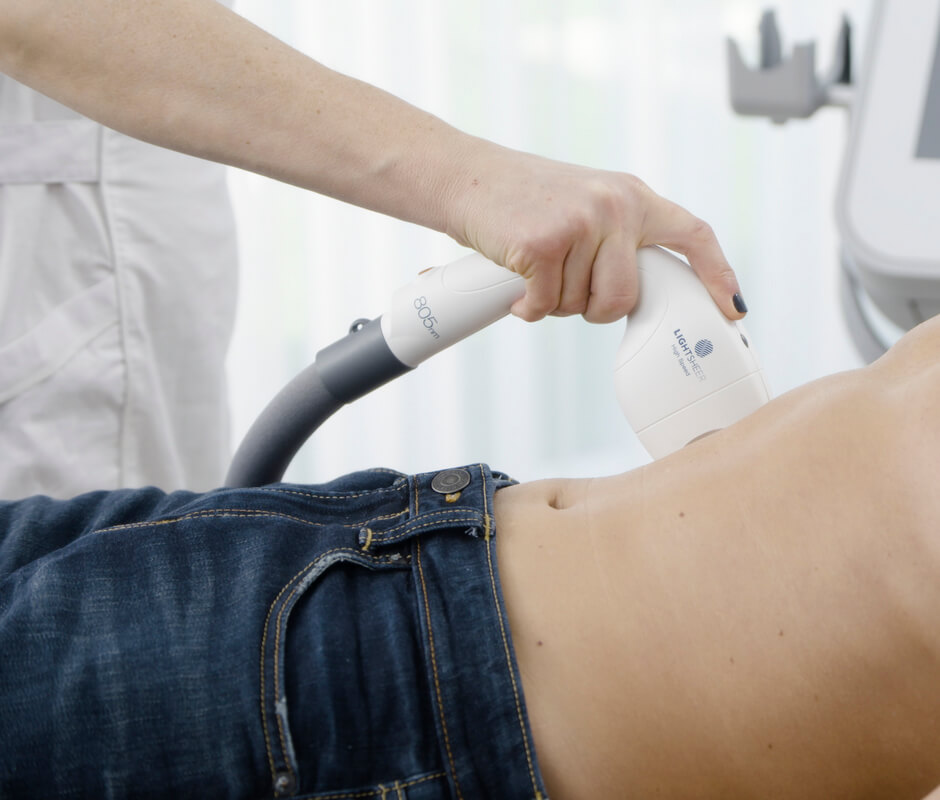|
|
|---|---|
Upper lip |
|
Underarms |
|
Bikini area (bikini line + brazilian + inner buttocks) |
|
Lower legs (+ knees) |
|
Package Minimum (underarms + bikini area + lower legs) |
|


LASER hair removal
Diode laser Lumenis LighSheer (805 nm)
Fast, comfortable, immediate visible effect and lasting results.
Our experience combined with modern American technology.

WHAT IS THE UNIQUENESS OF Lumenis lightsheer?
High Speed is a high-speed vacuum technology that significantly speeds up the procedure and provides a vacuum massage-like sensation . ChillTip is an integrated contact cooling technology that provides very precise hair removal even in the smallest areas.
TREATMENT PROCEDURE
During a laser hair removal session, you will be provided with a consultation:
We will find out together whether the procedure is suitable for you (expectations, indications and contraindications). We will give you a detailed overview of the procedure, make recommendations for skin care after the session and schedule your next visit.
Next, depending on the hair characteristics and area size, we choose the mode in which we will work:
HighSpeed - very fast, comfortable (feels like a vacuum massage), ideal for larger areas (underarms, bikini, legs) and thicker hair. ChillTip - slower, very accurate, suitable for smaller areas (fingers, face) and thin hair.
No need to apply gel in the HighSpeed mode. The unique vacuum technology ensures high efficiency and even painless sensations during the procedure.
In the slower Chill mode, we apply a conductive gel on the skin. A special contact crystal cooling of the skin is used before, during and after the procedure.

lumenis lightsheer BEFORE&AFTER





price
FAQ
HOW SOON WILL I SEE THE RESULT?
The results will be visible after the first session: hair will begin to fall out within the first 10-14 days. Gradually, during the course of the treatment, the hair will become thinner, lighter, and sparser, until it reaches a very minimal growth (occasionally a few thin hairs).
The true effectiveness of the procedure is assessed at the end and after the course, because fine hair is more difficult to remove and the result should be long-lasting. Fortunately, the Lumenis LightSheer laser is proven to be effective and allows you to maintain the result for a long time.
IS IT AN EFFECTIVE WAY TO REMOVE BLOND/GRAY/RED HAIR?
The principle of laser technology is to heat up the pigment - eumelanin (dark pigment) - and thus destroy the hair follicle.
Blond/red hair also has a pigment, but it is pheomelanin, and it absorbs laser radiation much worse, and therefore heats up worse.
Light-based treatments CANNOT effectively kill lighter-coloured hair such as blonde, grey or white, without inflicting excessive damage to the surrounding skin.
There is a chance to try the electrolysis hair removal - this is a longer and more uncomfortable, but quite effective method.
CAN IT BE DONE IN SUMMER? ON TANNED SKIN?
In summer - yes, as long as you follow the rules of pre- and post-treatment patient care. According to these rules, laser treatments CANNOT be provided on FRESHLY tanned skin. Tanned skin = damaged skin, so it is not safe to perform light-based treatments. Better safe, than sorry.
On closed areas (underarms, bikini) laser hair removal is usually performed without strict limitations.
On open areas, we work more delicately, but before and after the session, you must follow the rules of protection against UV radiation.
IS IT SAFE DURING PREGNANCY?
There is currently no evidence that laser hair removal is risky for pregnant women, but we recommend that you wait until your hormones are stabilized before starting the course (in case of breastfeeding, 2 months after the end of lactation).
IS THERE A CHANCE THAT HAIR GROWTH WILL RESUME?
Although we fully expect long-term results (from 1 to 7 years), unfortunately, there is a risk of hair growth activation due to spontaneous changes in the body.
Hair growth and development is a complex process that depends on many factors, including hormonal changes (pregnancy, hormone therapy, menopause) or significant stress.
ARE THERE ANY RISKS ASSOCIATED WITH LASER hair removal?
We work with new and high quality equipment, using our experience and individual approach to minimize any risks. To this end, we perform a thorough consultation and skin examination prior to the procedure and provide recommendations for aftercare to avoid any unwanted consequences:
burns (caused by sunbathing, use of self-tanners, alcohol or active substances on the treatment area)
pigmentation changes (same reasons + non-compliance with recommendations)
redness and swelling (individual skin sensitivity, non-compliance with recommendations)
paradoxical hypertrichosis (individual sensitivity)
scarring (due to a tendency to scar formation, especially keloid scars).
We have listed these risks for your information only. In our practice, these are extremely rare (<1%) situations.
CAN LASER HAIR REMOVAL CAUSE CANCER?
If the procedure is performed well and the recommendations are followed - no.
Studies have not found a clear correlation between the effect of laser light (non-ionized) and oncological processes. While we believe the scientific studies, we avoid/mask moles and recommend following a high UV protection regimen to be safe.
DOES LASER AFFECT OTHER ORGANS?
Diode laser radiation (805 nm) reaches a depth of only 4 mm. It is at the dermal (skin) level, so it does not affect other organs. It also has no effect on reproductive system.